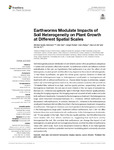Mostrar o rexistro simple do ítem
Earthworms Modulate Impacts of Soil Heterogeneity on Plant Growth at Different Spatial Scales
| dc.contributor.author | Adomako, Michael Opoku | |
| dc.contributor.author | Xue, Wei | |
| dc.contributor.author | Roiloa, Sergio | |
| dc.contributor.author | Zhang, Qian | |
| dc.contributor.author | Du, Dao-Lin | |
| dc.contributor.author | Yu, Fei-Hai | |
| dc.date.accessioned | 2022-04-20T09:09:09Z | |
| dc.date.available | 2022-04-20T09:09:09Z | |
| dc.date.issued | 2021-12-23 | |
| dc.identifier.citation | Adomako MO, Xue W, Roiloa S, Zhang Q, Du D-L and Yu F-H (2021) Earthworms Modulate Impacts of Soil Heterogeneity on Plant Growth at Different Spatial Scales. Front. Plant Sci. 12:735495. doi: 10.3389/fpls.2021.735495 | es_ES |
| dc.identifier.issn | 1664-462X | |
| dc.identifier.uri | http://hdl.handle.net/2183/30501 | |
| dc.description.abstract | [Abstract] Soil heterogeneity (uneven distribution of soil nutrients and/or other properties) is ubiquitous in nature and can greatly affect plant growth. As earthworm activity can influence nutrient redistribution in the soil, we hypothesize that earthworms may alter the effect of soil heterogeneity on plant growth and this effect may depend on the scale of soil heterogeneity. To test these hypotheses, we grew the clonal grass Leymus chinensis in three soil treatments (heterogeneous large vs. heterogeneous small patch vs. homogeneous soil treatment) with or without earthworms [i.e., Eisenia fetida Savigny (Lumbricidae, epigeic redworm)]. In the heterogeneous treatments, the soil consisted of patches with and without 15N-labeled litter (referred to as high- and low-quality patches, respectively), and in the homogeneous treatment, the soil was an even mixture of the two types of soil patches. Biomass of L. chinensis was significantly higher in the high- than in the low-quality patches, showing the foraging response; this foraging response occurred at both scales and under both earthworm treatments. Compared to the homogeneous treatment, the heterogeneous large patch treatment increased biomass of L. chinensis without earthworms, but decreased it with earthworms. In contrast, biomass of L. chinensis in the heterogeneous small patch treatment did not differ from that in the homogeneous treatment, irrespective of earthworms. Belowground biomass was much greater in the heterogeneous small than in the heterogeneous large patch treatment without earthworms, but it did not differ between these two scale treatments with earthworms. In the heterogeneous treatments, soil 15N was greater in the high- than in the low-quality patches, but this effect became much weaker with than without earthworms, suggesting that earthworm activity homogenized the soil. We conclude that earthworms can change the impact of soil heterogeneity on plant growth via homogenizing the soil, and that this effect of earthworms varies with patch scale. Such scale-dependent interactive effects of soil heterogeneity and earthworms could be a potential mechanism modulating plant community structure and productivity. | es_ES |
| dc.description.sponsorship | This study was supported by the National Natural Science Foundation of China (31800341) and the Ten-Thousand-Talent Program of Zhejiang Province (2018R52016) | es_ES |
| dc.description.sponsorship | China. National Natural Science Foundation of China; 31800341 | es_ES |
| dc.description.sponsorship | China. Ten-Thousand-Talent Program of Zhejiang Province; 2018R52016 | es_ES |
| dc.language.iso | eng | es_ES |
| dc.publisher | Frontiers | es_ES |
| dc.relation.uri | https://doi.org/10.3389/fpls.2021.735495 | es_ES |
| dc.rights | Atribución 4.0 Internacional | es_ES |
| dc.rights.uri | http://creativecommons.org/licenses/by/4.0/ | * |
| dc.subject | Clonal plant | es_ES |
| dc.subject | Environmental heterogeneity | es_ES |
| dc.subject | Foraging response | es_ES |
| dc.subject | Leymus chinensis | es_ES |
| dc.subject | 15N-labeled litter | es_ES |
| dc.subject | Patch scale | es_ES |
| dc.title | Earthworms Modulate Impacts of Soil Heterogeneity on Plant Growth at Different Spatial Scales | es_ES |
| dc.type | info:eu-repo/semantics/article | es_ES |
| dc.rights.access | info:eu-repo/semantics/openAccess | es_ES |
| UDC.journalTitle | Frontiers in Plant Science | es_ES |
| UDC.volume | 12 | es_ES |
| UDC.startPage | 735495 | es_ES |
| dc.identifier.doi | 10.3389/fpls.2021.735495 |






